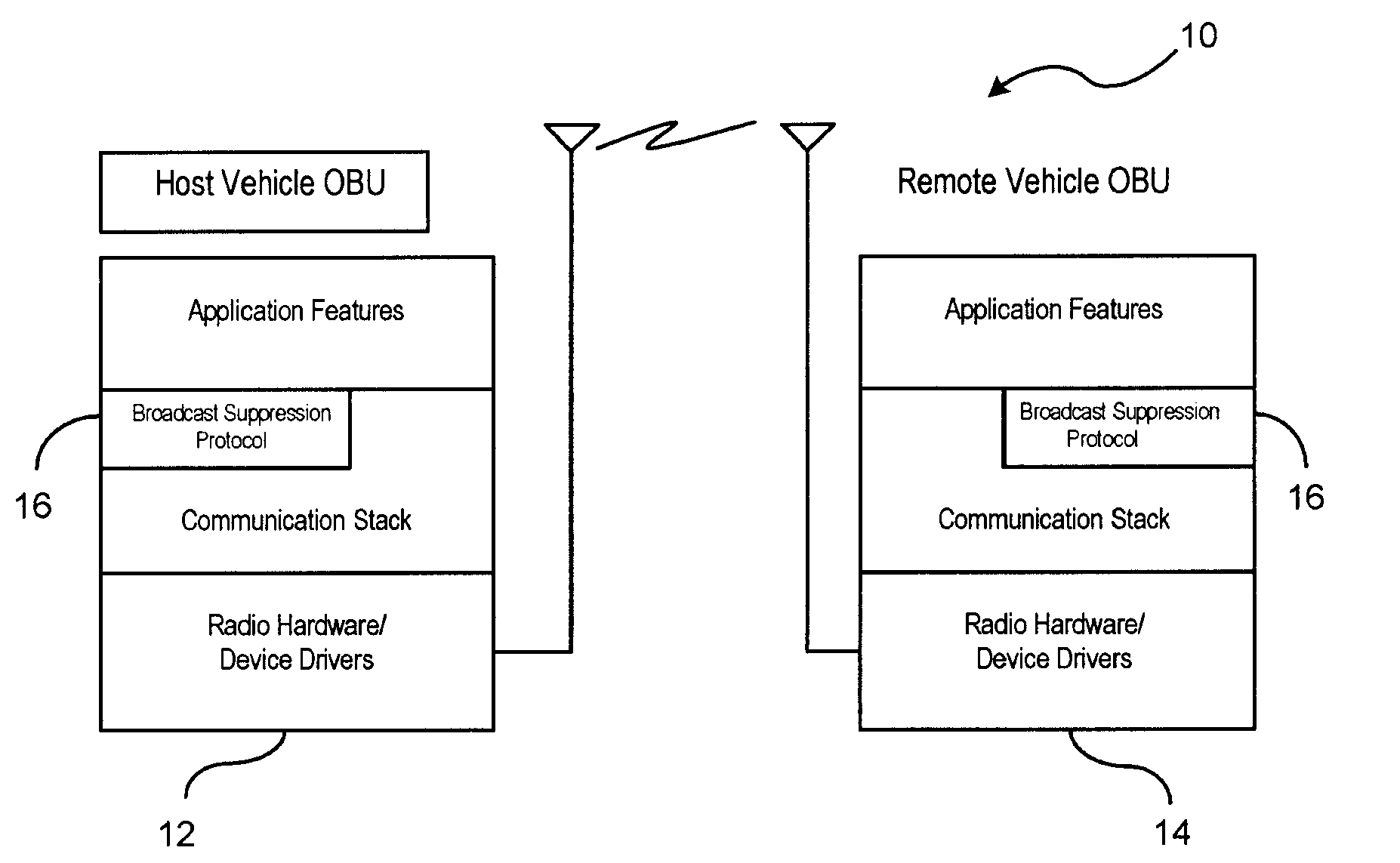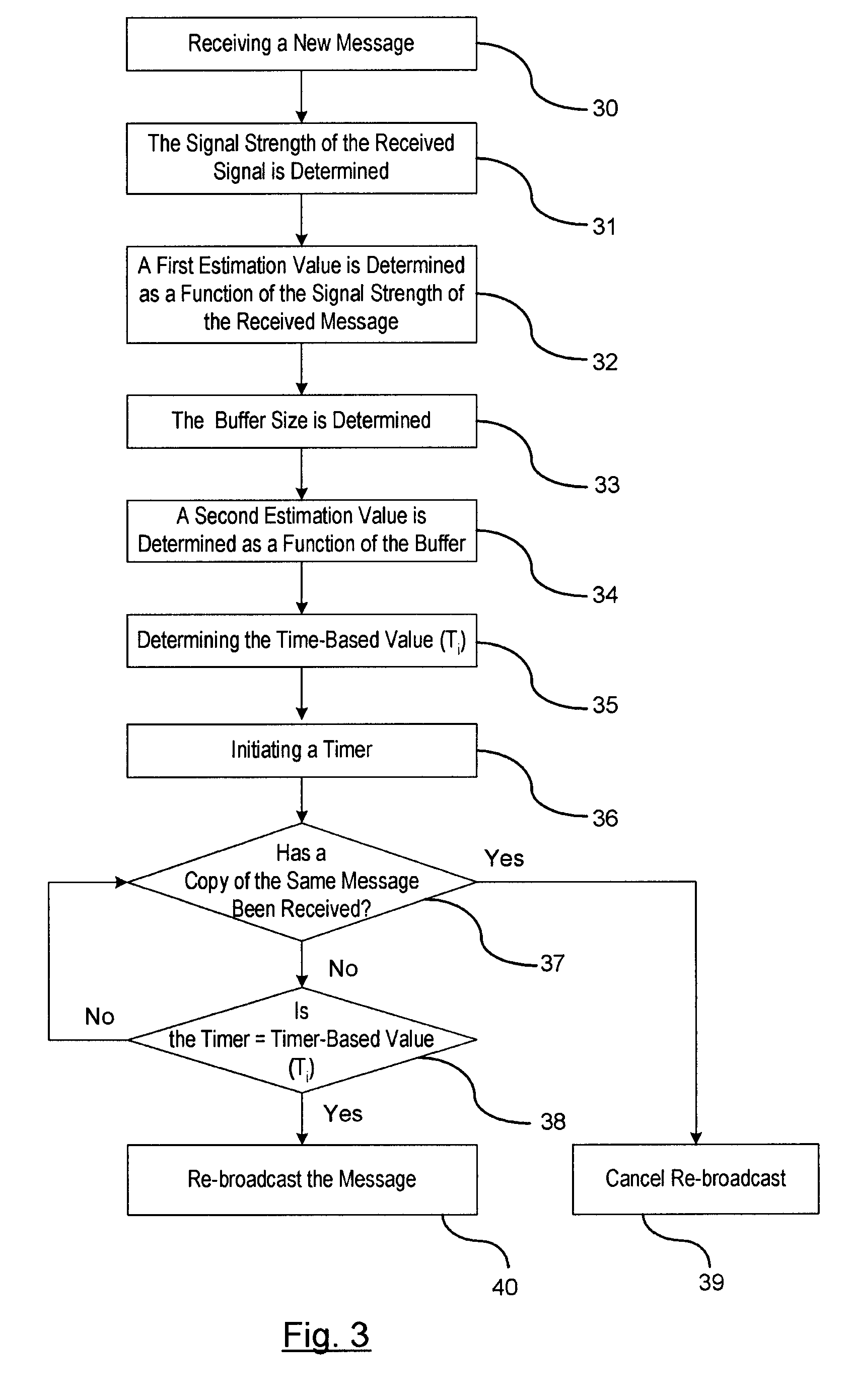Redundant message packet suppression for in-vehicle ad hoc network
a vehicular ad hoc network and message packet technology, applied in data switching networks, frequency-division multiplexes, instruments, etc., can solve problems such as packet collision, message flood, broadcast storm, etc., and achieve reliable and efficient message distribution
- Summary
- Abstract
- Description
- Claims
- Application Information
AI Technical Summary
Benefits of technology
Problems solved by technology
Method used
Image
Examples
first embodiment
[0020]In a first embodiment, a timer-based approach is provided for determining whether to suppress a re-broadcast message using the timer-based approach. When a respective vehicle receives a new message packet, the vehicle calculates a time-based value Ti. Time-based value Ti represents a delay in re-broadcasting the message packet so that a determination may be made of whether a duplicate message has been received prior to the delay expiring.
[0021]The time-based value Ti is determined as a function of a first estimation value and a second estimation value. The first estimation value is calculated as a function of the signal strength of the message packet as received by the vehicle receiver. That is, when the vehicle receiver receives the new message packet, a receiving circuit measures the signal strength of the received wireless message. The RSSI 20 is provided to the controller 22 for determining the signal strength of the received signal broadcasting the message packet. The RSS...
second embodiment
[0025]In a second embodiment, a probability-based approach is provided for determining whether to suppress a re-broadcast message packet. When a respective vehicle receives a new message packet, the vehicle calculates a probability-based value Pi. The probability-based value Pi represents a probability value of a willingness to re-broadcast the newly received message packet.
[0026]The probability-based approach utilizes the first estimation value and the second estimation value as described above. The probability Pi is determined based on the following formula:
Pi=α2(1-si-SoptS)+β2(1-biB)eq.(4)
[0027]Suppression of the message is determined by comparing the probability-base variable Pi to a respective triggering indicator. The triggering indicator is generated by a respective triggering function. In this embodiment, the respective triggering indicator is a randomly generated value Prn and the respective triggering function is a probability density function, preferably a uniform probabi...
third embodiment
[0028]The third embodiment represents a hybrid-based approach. The hybrid approach includes the formulas shown in equations (3) and (4) for determining whether to re-broadcast the message packet. In the hybrid-based approach, when the vehicle receives a new message packet, the controller calculates the time-based value Ti using formula shown in equation (3) and a probability-base variable Pi using the formula shown in equation (4). The timer is initiated for delaying the re-broadcasting of the message packet. The calculated time-based value Ti is decremented until the time expires. If a duplicate copy of the message packet is received before the delay expires, then the controller cancels the re-broadcasting of the respective message. If a duplicate copy of the message packet is not received before the delay expires, then a further determination is made whether to re-broadcast the message packet based on the probability-based value Pi. The probability-based value Pi is compared to th...
PUM
 Login to View More
Login to View More Abstract
Description
Claims
Application Information
 Login to View More
Login to View More - R&D
- Intellectual Property
- Life Sciences
- Materials
- Tech Scout
- Unparalleled Data Quality
- Higher Quality Content
- 60% Fewer Hallucinations
Browse by: Latest US Patents, China's latest patents, Technical Efficacy Thesaurus, Application Domain, Technology Topic, Popular Technical Reports.
© 2025 PatSnap. All rights reserved.Legal|Privacy policy|Modern Slavery Act Transparency Statement|Sitemap|About US| Contact US: help@patsnap.com



